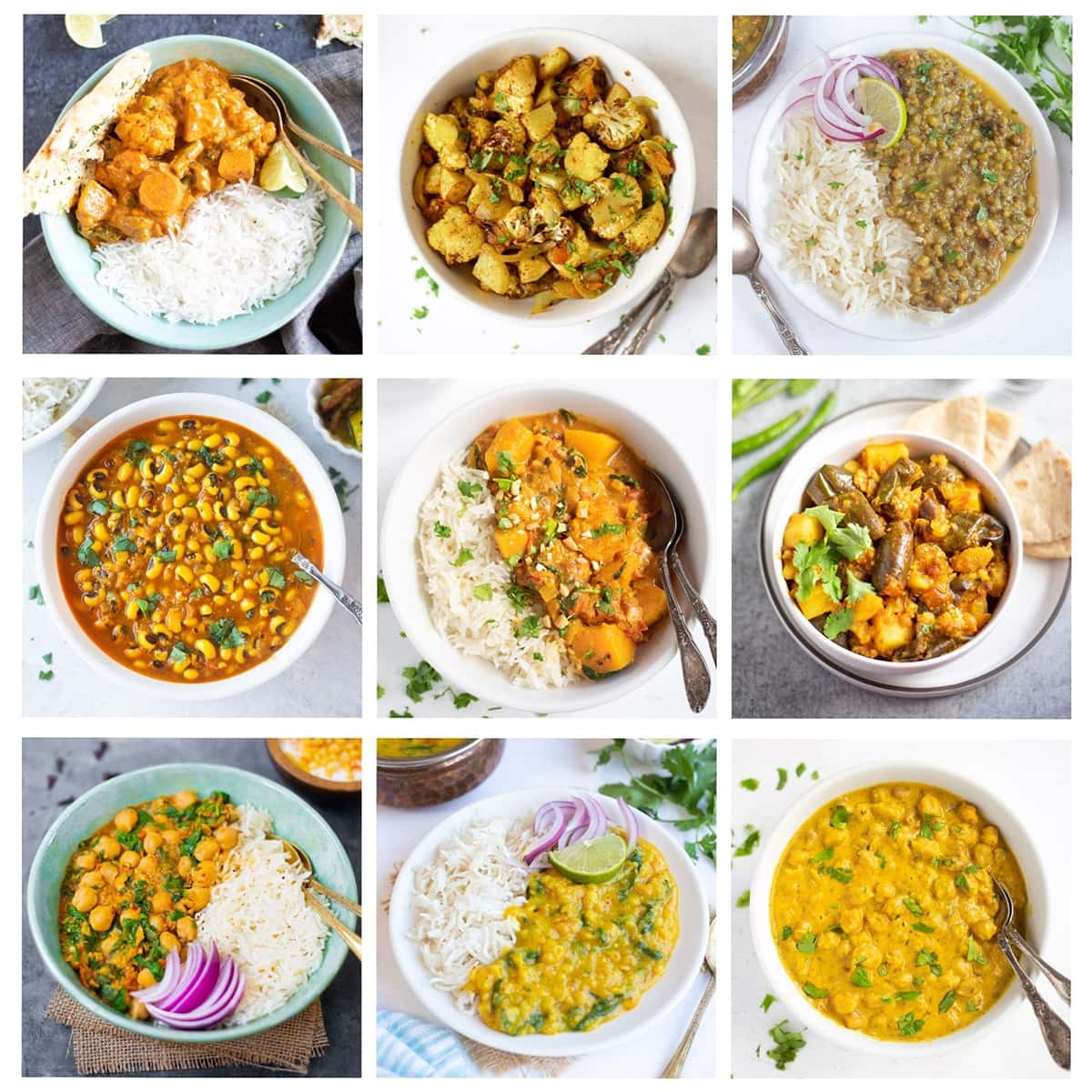Embark on a culinary journey through the vibrant world of Indian vegan cuisine! Tonight, ditch the takeout and discover the incredible depth and diversity of flavors waiting to be unleashed in your kitchen. From aromatic spices to hearty textures, vegan Indian food offers a delightful blend of health benefits and cultural richness. Prepare to be amazed by the simplicity and satisfying results of these plant-based masterpieces.
This exploration delves into five popular vegan Indian dishes, providing detailed recipes and insights into regional variations. We’ll guide you through the art of creating Chana Masala, a classic favorite, with step-by-step instructions and visual descriptions to ensure a flawless outcome. Learn expert tips and tricks for enhancing flavors, making substitutions, and adapting recipes to suit your preferences. Get ready to tantalize your taste buds and impress your guests with these authentic and delicious vegan Indian creations.
Introduction to Flavorful Indian Vegan Recipes
Embark on a culinary journey through the vibrant and diverse landscape of Indian vegan cuisine. Far from a restrictive diet, Indian vegan cooking offers a kaleidoscope of flavors, textures, and aromas, showcasing the ingenuity of centuries-old traditions adapted to plant-based lifestyles. Imagine a symphony of spices, from the warming embrace of turmeric to the fiery kiss of chili, creating dishes that are both nourishing and intensely satisfying. This exploration will unveil the delicious secrets behind these plant-powered masterpieces.
| A vibrant image depicting a colorful array of Indian vegan dishes: A steaming bowl of Chana Masala, its chickpeas glistening in a rich, reddish-brown sauce, sits beside a plate piled high with fragrant Jeera Rice, its grains glistening with toasted cumin seeds. A side dish of vibrant green Saag Paneer (using tofu instead of paneer) adds a splash of freshness, while a small bowl of tangy mango chutney offers a sweet and sour counterpoint. The background subtly hints at a bustling Indian marketplace, with colorful spices and fresh produce in the background, evoking a sense of warmth and abundance. | Indian vegan cuisine boasts a remarkable history, deeply intertwined with cultural and religious practices. Many traditional Indian dishes are naturally vegan, reflecting a long-standing vegetarian tradition. Beyond its cultural significance, a diet rich in Indian vegan recipes offers significant health benefits. The abundance of fresh vegetables, legumes, and spices provides a wealth of vitamins, minerals, and antioxidants, promoting overall well-being and contributing to a balanced and healthy lifestyle. These dishes are not only delicious but also contribute to a sustainable and compassionate food system. |
Health Benefits of Indian Vegan Cuisine
The nutritional profile of Indian vegan dishes is remarkably diverse and beneficial. The generous use of lentils provides a substantial source of protein and fiber, contributing to satiety and digestive health. The abundance of vegetables introduces a wide array of vitamins and minerals, including Vitamin A from spinach and carrots, Vitamin C from tomatoes and peppers, and various B vitamins from legumes and grains. The liberal use of spices like turmeric, ginger, and garlic offers potent anti-inflammatory and antioxidant properties, supporting immune function and overall health. For example, a single serving of Dal Makhani (a creamy lentil dish) can provide a significant portion of your daily recommended fiber intake, aiding in digestion and promoting a healthy gut microbiome.
Cultural Significance of Indian Vegan Dishes
Indian vegan cuisine is deeply rooted in the country’s rich cultural and religious tapestry. Many traditional dishes, often prepared for religious festivals or special occasions, are naturally vegan or easily adaptable to vegan lifestyles. For instance, during festivals like Diwali, numerous vegan sweets and savory dishes are prepared and shared, reflecting a long-standing tradition of communal eating and celebrating with plant-based fare. These dishes are not just food; they represent traditions, family recipes passed down through generations, and a connection to a vibrant cultural heritage. The preparation and sharing of these meals often involve community participation, strengthening social bonds and fostering a sense of belonging.
Top 5 Popular Vegan Indian Dishes

Embark on a culinary journey through the vibrant world of Indian vegan cuisine. These five dishes represent some of the most beloved and readily accessible options, showcasing the incredible depth and diversity of flavors available without any animal products. Each recipe offers a unique taste experience, from the subtly sweet to the intensely spicy, highlighting the artistry of Indian cooking.
Five Popular Vegan Indian Dishes
| Recipe Name | Key Ingredients | Flavor Profile | Cooking Method |
|---|---|---|---|
| Dal Makhani | Black lentils (urad dal), kidney beans (rajma), butter (vegan), cream (vegan), ginger, garlic, tomatoes, onions, spices (turmeric, cumin, coriander, garam masala). | Rich, creamy, subtly sweet, and savory with a warm blend of spices. | The lentils and beans are simmered slowly for hours, developing a luxuriously smooth texture. The vegan butter and cream add richness. |
| Chana Masala | Chickpeas (chana), onions, tomatoes, ginger, garlic, a vibrant blend of spices including turmeric, cumin, coriander, chili powder, and garam masala. | Savory, tangy, and warmly spiced, with a delightful balance of heat and aromatic complexity. | Onions, tomatoes, and ginger-garlic paste are sautéed before adding chickpeas and a medley of spices. The dish is then simmered until the flavors meld beautifully. |
| Aloo Gobi | Potatoes (aloo), cauliflower (gobi), onions, tomatoes, ginger, garlic, a fragrant blend of spices including turmeric, cumin, coriander, and garam masala. | Earthy, slightly sweet, and savory, with a comforting warmth from the spices. | Potatoes and cauliflower florets are stir-fried with onions, tomatoes, and spices until tender and slightly browned, creating a harmonious blend of textures and flavors. |
| Vegetable Biryani | Basmati rice, mixed vegetables (peas, carrots, beans, potatoes), onions, saffron, fragrant spices like cardamom, cloves, cinnamon, and bay leaves. | Aromatic, fragrant, and subtly spiced, with a delightful interplay of sweet and savory notes from the vegetables and spices. | Rice is cooked with vegetables, spices, and saffron, creating a layered dish with a visually appealing and flavorful result. The saffron imparts a vibrant golden hue and delicate aroma. |
| Saag Paneer (Vegan) | Spinach (saag), paneer substitute (tofu or other vegan cheese), onions, ginger, garlic, green chilies, garam masala, and other spices. | Creamy, earthy, and savory, with a gentle warmth from the spices. The vegan paneer adds a satisfying texture. | Spinach is sautéed with onions, ginger, garlic, and spices until wilted. The vegan paneer is then added and gently cooked until heated through. |
Step-by-Step Recipe: Chana Masala
This vibrant and flavorful Chana Masala recipe is a testament to the depth and complexity achievable in vegan Indian cooking. The dish balances the earthy richness of chickpeas with a medley of aromatic spices, creating a satisfying and deeply satisfying culinary experience. Following these steps will guide you to a perfectly spiced and tender Chana Masala.
Ingredients
This recipe uses readily available ingredients to create a restaurant-quality Chana Masala at home. Precise measurements ensure consistent results, allowing you to replicate this dish time and again.
- 1 tablespoon vegetable oil
- 1 large onion, finely chopped (Imagine a finely diced onion, its translucent layers glistening under the light)
- 2 cloves garlic, minced (Picture tiny, pearly white garlic cloves, their pungent aroma already filling the air)
- 1 inch ginger, grated (A vibrant, pale ginger root, its fragrance hinting at the warmth to come)
- 1 teaspoon ground cumin
- 1 teaspoon ground coriander
- 1/2 teaspoon turmeric powder
- 1/4 teaspoon cayenne pepper (or more, to taste)
- 1/2 teaspoon garam masala
- 1 (14.5 ounce) can diced tomatoes, undrained
- 1 (15 ounce) can chickpeas, rinsed and drained (A can of chickpeas, their creamy beige color hinting at their soft texture)
- 1 cup vegetable broth
- Salt to taste
- Fresh cilantro, chopped (A vibrant bunch of cilantro, its bright green leaves promising a fresh, herbaceous finish)
Preparation Steps
The following steps Artikel the process of creating Chana Masala, from the initial sautéing of aromatics to the final simmering that develops the rich flavors. Each step contributes to the overall taste and texture of the final dish.
- Heat the oil in a large pot or Dutch oven over medium heat. Add the chopped onion and cook until softened and lightly golden, about 5-7 minutes. (Imagine the onions transforming from opaque white to a translucent golden hue, their edges slightly caramelized.)
- Add the minced garlic and grated ginger and cook for another minute until fragrant. (The aroma of garlic and ginger blends with the onions, creating a heady, savory scent.)
- Stir in the ground cumin, coriander, turmeric, cayenne pepper, and garam masala. Cook for 30 seconds, stirring constantly, until fragrant. (The spices release their potent aromas, filling the kitchen with a warm, inviting fragrance.)
- Add the diced tomatoes (undrained) and chickpeas to the pot. Stir well to combine. (The vibrant red of the tomatoes contrasts beautifully with the beige chickpeas, creating a visually appealing mixture.)
- Pour in the vegetable broth, bring to a simmer, then reduce heat to low, cover, and cook for at least 20 minutes, or until the chickpeas are tender and the sauce has thickened slightly. (The sauce gradually transforms into a rich, thick consistency, the flavors melding beautifully.)
- Season with salt to taste. Garnish with fresh cilantro before serving. (A sprinkle of fresh cilantro adds a vibrant pop of green and a fresh, herbaceous note.)
Serving Suggestions
Chana Masala is incredibly versatile and can be enjoyed in a variety of ways. It pairs perfectly with rice, naan bread, or roti, enhancing the overall dining experience.
- Serve hot over steamed basmati rice. (Imagine fluffy grains of basmati rice, perfectly absorbing the rich, flavorful Chana Masala.)
- Enjoy with warm naan bread, using the bread to scoop up the delicious sauce. (Soft, warm naan bread, perfect for soaking up every last drop of the flavorful Chana Masala.)
- Pair with roti for a more rustic, traditional feel. (The slightly chewy texture of the roti provides a lovely contrast to the creamy Chana Masala.)
From the comforting warmth of Chana Masala to the exciting exploration of regional variations, this culinary adventure has showcased the boundless possibilities of vegan Indian cooking. The vibrant spices, diverse textures, and satisfying flavors promise a memorable dining experience, proving that plant-based meals can be both incredibly flavorful and deeply fulfilling. So, gather your ingredients, embrace the aromatic journey, and prepare to create your own unforgettable vegan Indian feast. Happy cooking!
Questions and Answers
Can I substitute ingredients in these recipes?
Absolutely! Many substitutions are possible. For example, you can often swap coconut milk for cashew cream, or adjust spice levels to your preference. The recipes provide guidance on suitable alternatives.
How long do these dishes take to prepare?
Preparation times vary depending on the recipe. Some, like Chana Masala, require a bit more time for simmering, while others are quicker to prepare. Each recipe includes estimated preparation and cooking times.
Are these recipes suitable for beginners?
Yes! While some recipes involve more steps, the instructions are clear and easy to follow, making them accessible to cooks of all levels. The step-by-step guide for Chana Masala, in particular, is designed for beginner cooks.
Where can I find the specific ingredients?
Most ingredients are readily available at Indian grocery stores or online retailers specializing in Indian spices and ingredients. Many larger supermarkets also carry a selection of common Indian spices.


